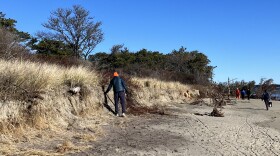Bowdoin College is one of the oldest institutions of higher learning in the country. And that means it also has some of the oldest buildings, dating as far back as the early 1800s.
In an effort to achieve net zero carbon emissions by the year 2042, the college is undertaking an ambitious plan to invest more than $100 million in renovations and a new electrified heating system for the campus.
This story is part of our series "Climate Driven: A deep dive into Maine's response, one county at a time."

Bringing Bowdoin's older buildings into the 21st century means tearing down plaster walls to exposed brick, installing five inches of metal wool insulation in those walls and on the roof, replacing drafty windows, and installing electric boilers or heat pumps.
Director of Capital Projects John Simoneau says these continuous barriers of insulation can make buildings airtight, similar to the passive house design concept.
"One of the parts of passive house is to have these really tight buildings. But even buildings that are not passive house like these still have the same air barrier system, you've got it tied into the windows, the windows have to have a really low leakage rate and that is part of the energy efficiency of these structures," Simoneau says.
Bowdoin plans to spend more than $100 million dollars over the next 15 years on campus renovations, preparing buildings for the installation of a new low-temperature hot water heating and cooling system that will begin in 2037, and take five years to complete.

It will replace the natural gas-fired power plant that uses high temperature hot water and steam and is responsible for 75% of the campus's carbon emissions. Keisha Payson, Director of Sustainability, says the college isn't committing to any particular technology at this point, believing that advances in geothermal, battery storage, nuclear fusion, green hydrogen and carbon recapture will emerge in the next 15 years.
"We'll purchase renewable energy credits and carbon offsets to become carbon neutral. But at the same time make it very clear that we're not done. That we are going to come up with a new plan to reduce our fossil fuel use, and that's the 2042 campus decarbonization plan that we released last year," Payson says.
Payson says a 29% reduction in campus emissions along with the credits and offsets allowed Bowdoin to become carbon neutral in 2018, meaning the carbon emitted by the campus was offset. Second Nature, a nonprofit that reports higher education institutions' climate action progress, says about 12 schools, including Bowdoin, Bates and Colby are carbon neutral, out of 400 that have pledged to reach carbon neutrality as soon as possible.
But the goal at Bowdoin is to become net zero —that is, to reduce emissions so that there is little or no carbon to offset.
Ninety percent of its electricity already comes from solar power, through a 5000-megawatt array near campus and an agreement to buy another 5000 megawatts from a community solar array in Farmington. Payson says as more campus systems are electrified, and more employees begin to use EVs, Bowdoin will have to invest in more renewable energy projects to meet its growing needs, to become fossil fuel free and reach net zero emissions by 2042.
Building materials are another part of the strategy. The newest structures on campus, an academic hall and the John and Lile Gibbons Center for Arctic Studies, are constructed of fabricated mass timber instead of steel and concrete. HGA, Bowdoin's engineering firm, says these are the state's first commercially scaled mass timber buildings. The material was sourced from Austria, as there are no manufacturers in the eastern U.S. HGA'S Lauren Piepho says the use of Mass Timber reduces the building's embodied carbon by nearly 10%.

"All of the carbon and all of the emissions needed to, say, fabricate, to produce, to transport those pieces is typically less than the amount of carbon that is sequestered as that tree has grown so you're looking at kind of net-negative carbon emissions for most wood members," says Piepho.
And as Simoneau says, "The carbon stays in the structure....for the life of the building."
Simoneau says the negative carbon footprint of the timber elements, nearly 65,000 kilograms of CO2, is equivalent to taking 15 cars off the road for a year. HGA Project Manager Rebecca Celis says Bowdoin also chose mass timber in part to demonstrate the potential for developing the industry in Maine.
"Part of the rationale for that was to try to show others the viability of mass timber as a structural system, its benefits, its challenges and how to kind of help spur that economic investment, especially as Maine has seen a decrease in use of its paper mills," Celis says.
And while Bowdoin has a healthy endowment, and generous benefactors, it's had to borrow to pay for all of these initiatives says Matt Orlando, the college's senior vice president of finance.
"The reality is for energy projects like this, it's hard to raise gifts. Most people don't want to put their name on a steam line distribution that runs underground. So it's typically debt-funded, so we're using the college's debt capacity to borrow money."}
Second Nature says about 400 U.S. colleges and universities have pledged to be net zero no later than 2050. Climate scientists say getting to net zero emissions, not just carbon neutrality, is the most important goal in the effort to address climate change.





